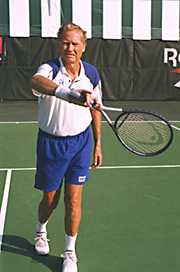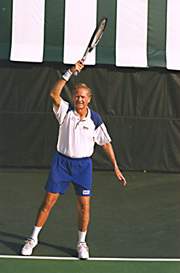|
TennisOne Lessons
Step with your right foot to the side, and, simultaneously, turn sideways; then take your racket back. Be sure your right leg is flexed as you rotate your trunk, hips, and shoulders. Your whole upper body should be perfectly balanced. Your extended left hand will help you get a solid base. It does not matter how high you take your racquet, whether closed or open, as long as your racket head is closed and below the ball at the end of your back swing.
Lay your wrist back and start your forward swing. Because of the grip, your contact point will be farther out in front and your elbow will be slightly bent. The hip, trunk, and shoulder rotation should be very pronounced. The rotation of the forearm and wrist
Unlike a regular forehand drive where the racket goes in line with the direction of the ball, and your thumb shows the direction; now the your racket should rotate towards your little finger -- the motion is distinctly from right to left. Acceleration and spin If you brush up sharply just before or at the impact, you will add more topspin to the ball. The wrist rolls over in a whip-like action to increase the acceleration.
The follow though
The right shoulder will have come around ahead of the right leg, and the racket may finish over your head, across your shoulder, around your neck or down next to your hip. If you are swinging at high speed, the rotational force of the stroke will lift your left foot off the ground and then your right foot will also come off the ground. Some players can generate so much centrifugal force that they will leave the ground by several inches. Recovery Your body will be leaning towards your left so that it will be easy for you to save a step if you played your shot from the deuce court side. If you are already in the ad court side, you may have to take a few quick, cross-over steps to get back into position. The bonus benefit. When players started to use the open stance forehand, I was surprised how many outright winners can be made either by hitting the ball inside out to the opponent’s backhand or down the line to the opponent’s forehand. It has now become apparent that, unlike in other strokes, there is no "clue utilization." The opponent has no way of reading where the ball is going. How to practice the strokeStep 1 From the open stance preparation, self-toss a ball up in the air with a very abbreviated back swing; hit the ball while concentrating to swing to your little finger with an outside-in motion. Step 2 Repeat the same exercise, but this time bounce the ball on the ground. Step 3 Take a full back swing while doing the same exercise. Step 4 Practice running around your backhand by side-stepping quickly to your backhand side and repeat the same exercise. Step 5 Practice the same exercise using cross-over steps. Step 6 Have a practice partner feed you balls. Hit alternating inside-out shots to the opponent’s backhand and down-the-line shots. Step 7 Have your partner feed you a short ball and practice "automatic put-a-ways." Step 8 Take a stance behind the baseline, a little to the left of the center line. Now start to rally deep balls with your practice partner, and try to run around as many backhands as possible. Hit inside out to your opponent’s backhand. Whenever you get a short ball, whack it for a cross-court winner, or wrong foot the opponent by hitting a winner down the line. Step 9 Rally inside-out shots followed by down-the-line shots. Step 10 When you get a short ball and you decide to hit it down the line, go to the net and expect to play a volley or an overhead. Dennis Van der Meer, voted U.S. Olympic Development Coach
of the Year, has taught more people to play and teach tennis
than anyone in the history of the game. Dennis Van der Meer and his staff can be reached in the USA
by phoning 1-800-845-6138 or faxing (843) 785-7032. From outside
the United States, dial 001-843-785-8388 and fax 001-843-785-7032. Send E-Mail to tennis@vandermeertennis.com or
stop by the web site: www.vandermeertennis.com
|
Last Updated 9/1/98. To contact us, please email to: webmaster@tennisone.com TennisONE is a registered trademark of TennisONE and SportsWeb ONE; Copyright 1995. All rights reserved. |
||||||

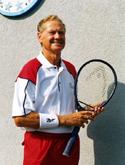 In today's
game, the classic forehand drive played with an eastern forehand
grip is being replaced by the semi-western or western forehand
drive. This modern stroke allows the player to make a powerful
return off medium and high bouncing balls and short balls can
be put away as an almost automatic.
In today's
game, the classic forehand drive played with an eastern forehand
grip is being replaced by the semi-western or western forehand
drive. This modern stroke allows the player to make a powerful
return off medium and high bouncing balls and short balls can
be put away as an almost automatic.
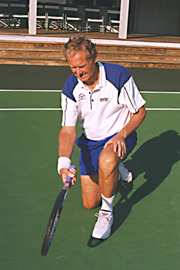 Place your racket
on the ground and pick it up at the handle. You will automatically
have a semi-western grip. If you want more of a full western,
just turn your hand further under the racket.
Place your racket
on the ground and pick it up at the handle. You will automatically
have a semi-western grip. If you want more of a full western,
just turn your hand further under the racket.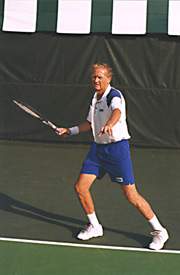
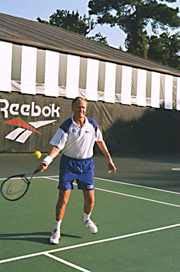 The forward
swing
The forward
swing